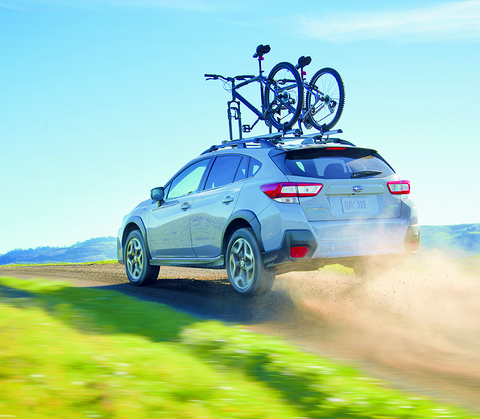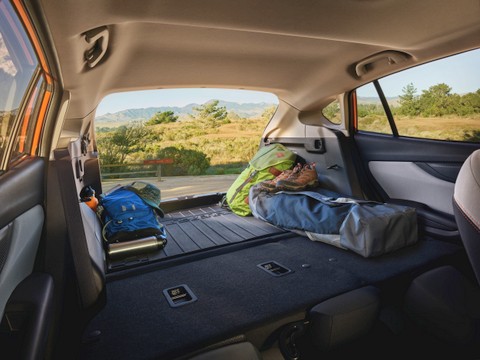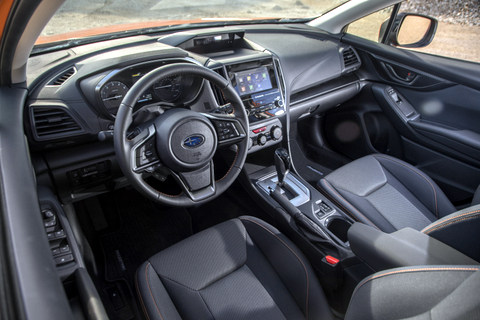Adventurous Spirit Packed With Value
By Lynne Hall and Larry E. Hall
Subaru has long stood by the horizontally opposed engine to power its cars. While proven to be reliable, it had a reputation for just so-so fuel economy. That changed a few years back, and the all-new 2018 Crosstrek continues in Clean Fleet Report’s All-Wheel Drive 30 MPG Club – with 33-mpg highway/27 city/29 combined when equipped with a continuous variable transmission (CVT). (Choose the manual shifter and fuel economy drops to 29 highway/23 city/25 combined.)
Introduced as a 2014 model, the Crosstrek is the result of a successful formula Subaru has used before: Take a core vehicle, alter the bones, jack up the suspension, add some body cladding and, viola, a new model. In this case, the donor car is the Impreza hatchback, which was the first Subaru model built on the company’s Global Platform, also a member of the 30 MPG AWD Club.
Impreza DNA

Impreza’s DNA is apparent in the Crosstrek’s profile, but from there the car takes off in a different direction. No other Subaru has the same grille or bumpers. The front A pillars are moved forward by 7.9 inches compared with the
Impreza. This not only improves cabin space, it adds athleticism to the look.
The 2018 Crosstrek rides on a 104.9-in. wheelbase, up 1.2-in. over the first-generation Crosstrek; it’s 0.6-inches longer than the previous model and 0.9-inches wider. Of course, like (almost) all Subarus, all-wheel drive is standard.
The most notable, visual difference between the two cars is ground clearance, which has been cranked up three inches to 8.7 inches. Throw in muscular fender flares, along with dramatic 17-inch alloy wheels, and the Crosstrek becomes an open invitation to travel farther once the highway ends.
Lynne says…
In our northwest corner of the country, motorists embraced Subarus back when quirky wasn’t hip. We, along with buyers in New England and Rocky Mountain states, knew for years that Subaru’s all-wheel-drive cars and wagons offered superior traction–not just on snowy roads, but on any slippery or uneven surface.

And that decision in 1994 to morph the Legacy wagon into the “world’s first sport utility wagon” and call it Outback? Brilliant, as consumers in all three markets flocked to dealers.
Since then, Subaru has perfected the recipe for creating a new model from an existing one—and I think the Crosstrek is its best yet.
As much as I liked the Outback, I thought the lower body cladding was a little over the top, almost garish. Conversely, Crosstrek stylists used restraint and added just the right amount of muscularity with the fender flares. Also, the wider track, added length and longer wheelbase result in balanced proportions.
Compared with the small crossover SUV sales leaders–and Toyota RAV4, Ford Escape and Honda CR-V—the Crosstrek has the look of a sport utility that wants to get out of town. It says, “Hey, throw a couple mountain bikes or camping gear in the back and let’s get a little dirty, maybe even muddy.”
It backs up that invitation with a ground clearance of 8.7 inches that’s more generous than the Jeep Grand Cherokee. While we couldn’t find time to do some semi-serious off roading, previous Subaru test drives have shown their ability to go just about anywhere short of rock crawling.
The Inside Story
Crosstreck’s well-laid-out interior follows Impeza. The cabin is minimal, but not spartan, with durable soft-touch materials covering upper surfaces for comfort, and plastic on lower panels for easy cleaning. Switchgear arranged on the center stack and surrounding the steering column has a sturdy feel.
Seats, front and rear, fall into the comfortable category. We found the space suitable for four adults (cramped with five), even if rear passengers were squeezed a bit for foot room. In case your passengers tend to be toddlers rather than adults, it’s easy to comfortably fit two front-facing car seats in the rear.
The 20.8 cubic feet behind the rear seat was more than adequate for a week’s worth of grocery shopping, and a standard waterproof cargo tray is a thoughtful feature. Rear seats are 60/40 split and fold completely flat, providing 55.3 cubic feet of space. That’s enough room for two mountain bikes. Or, with standard roof rails, heft the bikes onto the roof.
On the Road

In town behavior was standard Subaru—easy-to-drive, easy-to-park and easy to get in and out of. The Crosstrek doesn’t miss a beat on the pavement, either. Agile and racy are not in its dictionary, but predictable, smooth and comfortable describe its on-road behavior.
Granted, 152 horsepower doesn’t sound like much these days–and it’s not–but it is adequate to the task of motivating the 3,302-pound Crosstrek for 0-to-60 mph in a little more than nine seconds. Whenever editor/husband Larry expressed a want for a turbocharger, I gently reminded him that this little Subie was about fuel economy, not speed.
Our Premium model’s engine was hooked up to a continuously variable transmission (CVT), which for 2018 now incorporates seven stepped, predetermined ratios (controllable via paddle shifters) to mimic traditional gear shifting and mitigate the rubber-band sensation. Looking at my notes, I had checked hill hold as my favorite feature—take your foot off the brake when stopped on a hill, and the Crosstrek won’t roll backwards. I’m perplexed as to why more carmakers don’t have this feature.
Larry Says…
In 2005, Subaru made a move to present its automotive assets with style and content that would attract a broader audience. The company’s goal was to elevate its image to a “premium niche brand”—not a luxury brand, but one consumers were willing to pay a higher price (for perceived quality and features like standard all-wheel drive).
The second generation 2018 Crosstrek takes a simpler approach and isn’t quite as animated as the rest of the lineup. The upside to this is the Crosstrek offers a very good value proposition.
Consider: the base 2.0i Crosstrek starts at $22,795 plus a $915 destination charge. This least-expensive Crosstrek includes all-wheel drive with active torque vectoring, cruise control, 17-inch wheels and a rearview camera. Also standard is Subaru’s Starlink multimedia system with a 6.5-inch touchscreen, Apple CarPlay and Android Auto compatibility, AM/FM stereo, USB port with iPod control, Bluetooth audio streaming and an auxiliary jack.
Our Premium test drive model had sticker price of $23,595 including the $1,000 CVT. It added heated front seats, fog lights, a windshield wiper de-icer and heated side mirrors, a leather-wrapped steering wheel and a six-speaker audio system.
The top-line Crosstrek Limited starts at $28,450 and can top $30,000 with options. It includes leather interior, a CVT automatic transmission as standard, power driver’s seat, blind-spot monitoring with rear cross-traffic alert, automatic climate control, an 8.0-inch touch-screen infotainment system with AM/FM/HD Radio, CD player, dual USB inputs and voice-activated controls. A moonroof is optional on Premium and Limited trims, as is the EyeSight driver-assist and active-safety system with adaptive cruise control, pre-collision braking, lane-departure warning, and lane-keep assist package. Limited trims can also add a Harman/Kardon premium audio system, navigation, and reverse automatic braking.
Traction Options
While all-wheel drive is standard, the system differs depending on the choice of transmission. Without going into technical details, CVT models split torque 60/40 front-to-rear as the default, while the manual transmission system distributes torque 50/50. Both can direct torque to the wheels that slip to ensure traction.

Regardless of the model, the Crosstrek is available with one engine, a 2.0-liter horizontally opposed (“boxer”) four-cylinder engine. The boxer nickname comes from the way the pistons look when the engine is running—like a boxer throwing punches. The punches this boxer throws are 152 horsepower and 145 pounds-feet of torque. As for my wanting a turbocharger under the hood, that little more than nine second 0-to-60 edges on Prius territory, not what I prefer when merging into fast traffic.
Once up to speed, the 2018 Crosstrek felt solid and capable. Inside, wind noise was nearly nonexistent, and only on particularly rough concrete roads did we hear any commotion from below. Ride quality was very good, muting most small bumps, and reducing big ones to minor hiccups in the cabin.
Yes, Lynne, the Crosstrek is about fuel economy—and we did pretty good. Well, actually you did pretty good, since you were behind the wheel for most of the 215 miles during our week test drive. With about half of the miles driven on city streets, we managed to beat the EPA rating with 30.5 mpg combined.
Bottom Line
People buy Subarus for qualities other than glitz. The 2018 Subaru Crosstrek’s modest base price fetches the utility of a small wagon with a roomy cabin and cargo area that offers practicality and easy drivability. It will meet the needs of those who prioritize fuel economy over performance, contributing a small roll in saving the planet while exploring it.
Related Stories You Might Enjoy: More Off-Road Adventure Machines
News: 2019 Toyota RAV4 Hybrid Debuts in NY
Comparison Test: 2018 Volkswagen Atlas V6 vs. Four-Cylinder
Road Test: 2018 Volkswagen Golf Alltrack
Flash Drive: 2018 Jeep Wrangler & 2019 Jeep Cherokee
Road Test: 2017 Jeep Cherokee
Road Test: 2018 Chevrolet Equinox
Road Test: 2018 Subaru Outback
Road Test: 2017 Nissan Rogue Sport
Road Test: 2017 Jeep Renegade
Disclosure:
Clean Fleet Report is loaned free test vehicles from automakers to evaluate, typically for a week at a time. Our road tests are based on this one-week drive of a new vehicle. Because of this we don’t address issues such as long-term reliability or total cost of ownership. In addition, we are often invited to manufacturer events highlighting new vehicles or technology. As part of these events we may be offered free transportation, lodging or meals. We do our best to present our unvarnished evaluations of vehicles and news irrespective of these inducements.
Our focus is on vehicles that offer the best fuel economy in their class, which leads us to emphasize electric cars, plug-in hybrids, hybrids and diesels. We also feature those efficient gas-powered vehicles that are among the top mpg vehicles in their class. In addition, we aim to offer reviews and news on advanced technology and the alternative fuel vehicle market. We welcome any feedback from vehicle owners and are dedicated to providing a forum for alternative viewpoints. Please let us know your views at publisher@cleanfleetreport.com.

7 thoughts on “Road Test: 2018 Subaru Crosstrek Premium”